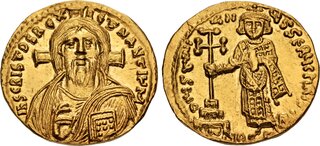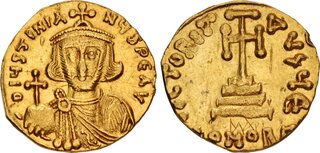Match 1:
| Classical Numismatic Group > Auction 126 | Auction date: 28 May 2024 |
| Lot number: 966 Price realized: This lot is for sale in an upcoming auction - Bid on this lot  | |
| Lot description: Justinian II. First reign, 685-695. AV Solidus (19.5mm, 4.45 g, 6h). Constantinople mint, 1st officina. Struck 692-695. Nimbate facing bust of Christ Pantokrator, raising hand in benediction and holding Gospels / Justinian standing facing, wearing crown and loros, holding cross potent set on two steps and akakia; A//CONOP. DOC 7a; MIB 8a; SB 1248. Toned with some luster, light scrapes on reverse, edge marks. Good VF. From the Family of Constantine Collection, assembled with guidance by Roland Michel, Geneva. The portrait of Christ that appears on this solidus issue marks the first representation of Christ on a coin. The Council in Trullo or the Quinisex Council was held during the reign of Justinian II in Constantinople following the Fifth and Sixth Ecumenical Councils. The assembly was called partly in order to address diverging practices in the east and west and to set church policy explicitly in written canons in order to discipline those who continued to engage in contrary practices. One of the canons set during the council concerned appropriate portrayals of Christ. Canon 82 cites 1st Corinthians 13:10 and makes use of similar language in Hebrews 10:1 to specify that "we decree that the figure in human form of the Lamb who takes away the sin of the world, Christ our God, be henceforth exhibited in images" (Quinisex Council, Canon 82). The text goes on to specify that Christ as a man ought be used in icons and visual depictions rather than the Agnes Dei. That same year, this issue of solidi was released into circulation by Justinian. The Council was very poorly received in the West and even denounced by some western thinkers. This monumental decision, however, greatly shaped the future of Byzantine coinage and concurrently stood in sharp contrast to the emergent Umayyad Caliphate's contemporary practice of avoiding depicting religious figures on coinage. Estimate: 1500 USD | 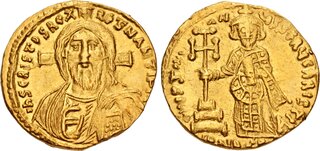 |
Match 2:
Match 3:
| Classical Numismatic Group > Auction 126 | Auction date: 28 May 2024 |
| Lot number: 969 Price realized: This lot is for sale in an upcoming auction - Bid on this lot  | |
| Lot description: Justinian II. Second reign, 705-711. AV Solidus (19.5mm, 4.43 g, 6h). Constantinople mint. Struck 705. Nimbate facing bust of Christ Pantokrator, raising hand in benediction and holding Gospels / Crowned facing bust of Justinian, wearing loros, holding cross potent set on three steps and patriarchal globus cruciger inscribed PAX. DOC 1; MIB 1; SB 1413. Lustrous, faint rotated double strike on obverse, some faint hairlines, trace deposits. EF. An outstandingly bold strike from detailed dies. From the Family of Constantine Collection, assembled with guidance by Roland Michel, Geneva. Estimate: 2000 USD | 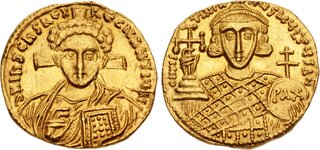 |
Match 4:
Match 5:
| Classical Numismatic Group > Auction 126 | Auction date: 28 May 2024 |
| Lot number: 922 Price realized: This lot is for sale in an upcoming auction - Bid on this lot  | |
| Lot description: Aelia Eudoxia. Augusta, AD 400-404. AV Solidus (19.5mm, 4.49 g, 6h). Constantinople mint, 5th officina. Struck under Arcadius, AD 397-402. Pearl-diademed and draped bust right, wearing earring and necklace; being crowned by manus Dei above / Victory seated right on cuirass and shield; supporting shield set on column and left knee with left hand and inscribing Christogram on it with stylus; Є//CONOB. RIC X 14 (Arcadius); Depeyrot 55/5; Biaggi –; Tolstoi 138 (this coin). Lightly toned, lustrous, a few tiny marks. EF. Very rare. A vibrant early strike with much of the die engraver's centering circle visible on both the obverse and reverse. From the Family of Constantine Collection, assembled with guidance by Roland Michel, Geneva. Ex William H. Williams Collection (Triton VI, 14 January 2003), lot 1128; Hermitage Museum Collection (per Tolstoi); Photiades Pasha Collection (possibly Hoffmann, 23 May 1890, lot 21 [not illustrated]). Aelia Eudoxia was a devout Christian and opponent of the heretical Arians. Nonetheless, Eudoxia found herself at odds with other Christian leaders. Her husband, the emperor Arcadius, showed little interest in serving as the benefactor of Christianity in the empire. Eudoxia subsequently stepped in to fill the void and became quite active in Church patronage. However, after the consul Eutropius was banished from the imperial court and subsequently executed, a friction developed between Eudoxia and the beheaded consul's ally, the Patriarch of Constantinople, John Chrysostom. Eutropius had initially helped install Eudoxia as empress by arranging her marriage to Arcadius. However, the consul fell out of favor with Eudoxia and other officials and additionally developed a bad reputation leading to his downfall. John Chrysostom's efforts delayed Eutropius' execution, but within a year the consul lost his head. A damnatio memoriae was additionally issued against the disliked consul. Tensions worsened between the two major figures in Constantinople's church life, the Empress and the Patriarch, when Eudoxia took umbrage at comments made by John in his sermons condemning women's elaborate dress, which Eudoxia took as aimed at herself. Eudoxia found cause against John on account of his failure to rebut Origen, the famous scholar from Alexandria whose teachings had found him out of favor with a number of church officials. Eventually, Eudoxia and her allies succeeded in ousting the Patriarch. However, his exile was short-lived. The populace threatened revolt and an earthquake suddenly struck, which Eudoxia interpreted as a sign of God's displeasure. The reconciliation was not to last. Not long thereafter John denounced the dedication of a statue of Eudoxia (one pillar of which survives to this day) and compared her to Herodias demanding the head of John the Baptist. The lawyer and historian Salamanes Hermias Sozomenos, or Sozomen, recounts the incident in his Historia Ecclesiastica, writing, "Herodias is again enraged; again she dances; again she demands the head of John in a basin" (Sozomen, Book VIII, Chapter 20). This led to a second trial of John. After the second trial "John held no more assemblies in the church, but quietly remained in the episcopal dwelling-house" (ibid, Chapter 21). He subsequently survived an assassination attempt before being ordered into exile. Once the people discovered his exile, a riot broke out and amidst the chaos "the church was suddenly discovered to be on fire." Subsequently, "[both] parties mutually accused each other of incendiarism" (ibid, Chapter 22). A mass arrest of John's allies followed. Eudoxia's victory was not to last, however, and she died shortly thereafter from an infection due to a failed seventh pregnancy. Estimate: 4000 USD | 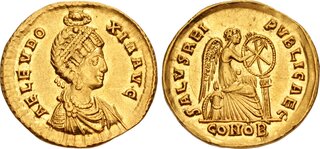 |



